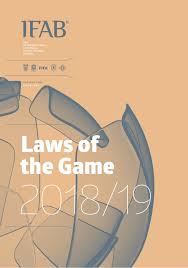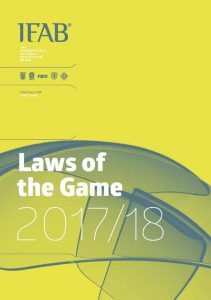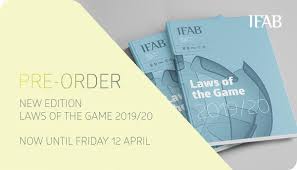LATEST NEWS…..Law changes for 2020-21
The latest version of the Laws (2019) came into effect on 1 June 2020
Law 1 – The Field of Play
• Goalposts and the crossbar may be a combination of the four basic shapes
Law 10 – Determining the Outcome of a Match
• Yellow cards (YCs) and warnings are not carried forward into kicks from the penalty mark
(KFPM)
• See also changes to Law 14 relating to KFPM
Law 11 – Offside
• Deliberate handball by a defending player is considered ‘deliberate play’ for offside
Law 12 – Fouls and Misconduct
• Handball:
• the boundary between the shoulder and the arm is defined as the bottom of the armpit
• ‘accidental’ handball by an attacking player (or team-mate) is only penalised if it occurs ‘immediately’ before a goal or clear goal-scoring opportunity
• A goalkeeper can receive a YC or be sent off (RC) for ‘illegally’ touching the ball a second
time after a restart (e.g. goal kick, free kick etc.) even if the touch is with the hand/arm
• Any offence (not only a foul) which ‘interferes with or stops a promising attack’ should result in a YC
• A player who fails to respect the 4m required distance at a dropped ball should receive a YC
• If the referee plays advantage or allows a ‘quick’ free kick for an offence which ‘interfered with or stopped a promising attack’, the YC is not issued
Law 14 – The Penalty Kick
• An offence by the goalkeeper is not penalised if a penalty kick misses the goal or rebounds from the goal (without a touch from the goalkeeper) unless the offence clearly affected the kicker
• The goalkeeper is warned for the first offence; it is a YC for any further offence(s)
• The kicker is penalised if the goalkeeper and the kicker offend at exactly the same timeVAR protocol
• Only one ‘TV signal’ is required for a VAR-only reviewGlossary
• A definition of the offence of holding has been included
• A player’s position at a restart is the position of the feet or any part of the body which is touching the ground (except as outlined in Law 11 – Offside)
Notes and brief details can be found here
Full details can be found on the IFAB website
2019:
This in summary includes:
- the introduction of yellow and red cards for misconduct by team officials
- a player being substituted having to leave the field of play at the nearest point on the boundary line
- at a goal kick and a free kick for the defending team in their own penalty area, the ball is in play once it is kicked, i.e. it does not have to leave the penalty area
- clearer wording for ‘handball’
- attacking team players must be at least 1m away from a ‘defensive wall’
- the goalkeeper only has to have one foot on the goal line at a penalty kick
- a new dropped ball procedure
Supporting documents can be founds here
There is also a new App available to download – get it now
2018:

Law amendments for 2018-19 have been published
See IFAB website
2017:

Update published on 5 May 2017.
You can go directly to the IFAB website for the pdf or word version of the updated Laws.
Click here to explore….pdf version or word version.
Or click here for the presentation of the Law changes 2017-18.
Other files relating to Law changes (2017) can be found by clicking here
Other guidelines:
for Return Substitutes and Temporary Dismissals (sinbins)
Three Laws have had heading amendments (2016):
Law 3 – The Players
Law 6 – The Other Match Officials
Law 10 – Determining the Outcome of a Match
Laws Overview – click on title for summary or individual law for details or for an Interactive view click here or below
1. The Field of Play
2. The Ball
3. The Players
4. The Players’ Equipment
5. The Referee
6. The Other Match Officials
7. The Duration of the Match
8. The Start and Restart of Play
9. The Ball In and Out of Play
10. Determine the Outcome of a Match
11. Offside (and 2015 Interpretation from FIFA)
12. Fouls and Misconduct
13. Free Kicks
14. The Penalty Kick
15. The Throw In
16. The Goal Kick
17. The Corner Kick
Procedures to determine the winner (Kicks from Penalty Mark)
FIFA Laws (click on picture below)
Latest amendments to the Laws – see links at bottom of page……
and Notes on the Laws plus Interpretation of the Laws of the Game
 FIFA Q&A 2006 (test / refresh your knowledge)
FIFA Q&A 2006 (test / refresh your knowledge)
You Are The Ref
Why not try your hand at some posers in Law.
See the YATR page…also regularly posted to York RA facebook page.
Key Changes
Football is a game rooted in tradition, and the Laws of the Game have undergone fairly minor changes since they were first drafted by England’s newly-formed Football Association in 1863. Nonetheless, while the aim has always been to preserve football’s original spirit, and to ensure that rules can be applied from elite to amateur level, several crucial changes have helped to enhance the sport over the years. Below is some of the key changes over the years:
1866: Forward passes permitted The most fundamental alteration was also the earliest, with forward passes permitted for the first time – provided there remained three defending players between the receiver and the goal. Previously, once the ball had been kicked, any player on the same team closer to the opponent’s goal was considered out of play and unable to receive the ball. This 1866 change represented the crucial first step away from sharing the original offside rule that remains in place in rugby, and allowed passing football to thrive.
1878: Whistle introduced
1891: The penalty kick introduced It took almost three decades from the first rules being drafted for the penalty, which has become such an integral part of modern football, to be instituted. Having previously operated on the quaint assumption that a gentleman would never deliberately commit a foul, football responded to increasing intensity and competitiveness by bringing in a measure known then as ‘the kick of death’. Until 1902, the penalty was not taken from a spot, however, but from anywhere along a 12-yard line.
1891: Referees enter the fray More recognition that the game had evolved from its gentlemanly roots came with the introduction of referees. In football’s early days, disputes had been settled by the two team captains, and later by two umpires – one per team – to whom appeals could be made. However, as the number of disputes and complaints grew, the need for an impartial arbiter became clear, and from 1891 the power to give penalties and free-kicks became the job of one man: the referee.
1912: Goalkeepers restricted It was a century ago this year that goalkeepers were forbidden from handling the ball outside the penalty area. This change came just three years after it was decided that the players filling this position should be visually distinctive from their team-mates by wearing a different colour, with green the general default.
1925: Offside changed again The revised offside rule was further relaxed in 1925 to allow a player to remain onside provided two, rather than three, opposition players stood between him and the goal. The result was an immediate increase in goalscoring, and this particular law was amended in attackers’ favour once again in 1990 to enable a player to remain onside by keeping level with his/her second-last opponent.
1958: Substitutes permitted The early history of the game includes several mentions of ‘substitutes’, but the purpose of these back-up players was merely to stand in if any of the 11 selected failed to turn up. However, the detrimental impact of injuries on matches eventually resulted in substitutes being permitted during the 90 minutes, although initially only for an injured goalkeeper and one other injured player. From the late 1960s, these rules were relaxed to allow substitutions for tactical reasons.
1970: Red and yellow cards introduced Championed by English referee Ken Aston, then an influential figure on the FIFA Referees’ Committee, this ‘traffic light’ system was aimed at ending confusion among players and spectators over a referee’s intentions. Red and yellow cards were first used at the FIFA World Cup™ of the same year and have been a fixture ever since, even spreading to several other sporting codes.
1992: Handling of “pass-backs” forbidden Another change aimed at tilting the balance of power in favour of attacking players was the International Football Association Board’s 1992 decision to forbid goalkeepers from handling the deliberate pass from a team-mate’s feet. Though initially greeted with widespread scepticism, this measure is now universally seen to have made a positive impact on the beautiful game.
1992: Laws revision simplified version of Laws
2012: Goal Line technology introduced
2016: Major re-write IFAB now responsible for Laws – David Elleray oversaw a complete re-write, reducing the words from some 20,000 by half. Plus changes to “triple punishment” and trials of Video Assistant Referee’s (VAR). Law changes also made and some changes to Law headings.
2019: IFAB App now available – IFAB released new App for all to use on the go
For further reading on FIFA and Refereeing click on link.
If you would like to view the latest amendments to the Laws click below on the relevant link:
Law amendments (offside interpretation) FIFA circular 3
Law amendments June 2014 FIFA circular
Law Amendments May 2012 FIFA circular 1302
Law Amendments Aug 2012 GLT FIFA circular 1315
Futsal Law Amendments July 2012 FIFA circular 1310
The Law changes agreed in March 2013 by the IFAB related mainly to clarification of Offside (Law 11). See the article on “Offside”.
See Law 11 above for latest interpretation (2015).
Other Versions of the game:
Mini Soccer
Why not try the new IFAB website for details of all Laws and Practical Advice for Officials.




